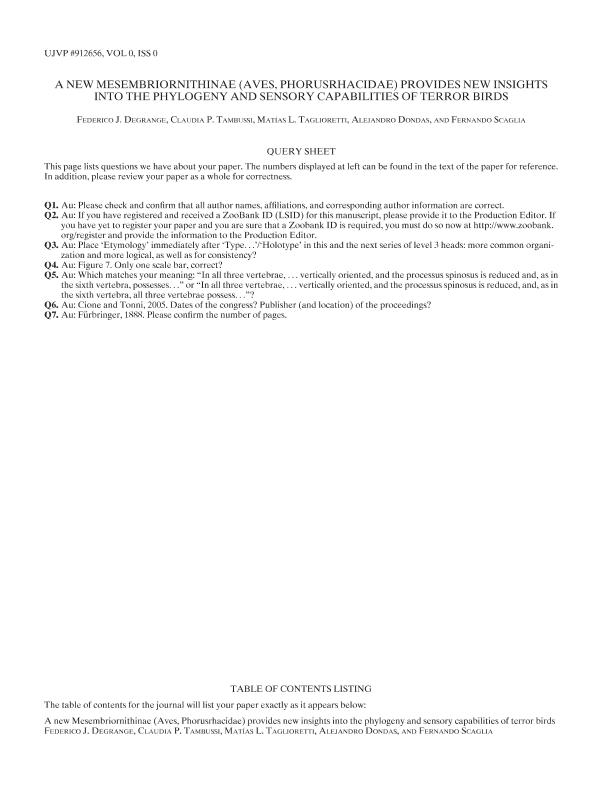Artículo
A new Mesembriornithinae (Aves, Phorusrhacidae) provides new insights into the phylogeny and sensory capabilities of terror birds
Degrange, Federico Javier ; Tambussi, Claudia Patricia
; Tambussi, Claudia Patricia ; Taglioretti, Matias Luciano
; Taglioretti, Matias Luciano ; Dondas, Alejandro; Scaglia, Fernando
; Dondas, Alejandro; Scaglia, Fernando
 ; Tambussi, Claudia Patricia
; Tambussi, Claudia Patricia ; Taglioretti, Matias Luciano
; Taglioretti, Matias Luciano ; Dondas, Alejandro; Scaglia, Fernando
; Dondas, Alejandro; Scaglia, Fernando
Fecha de publicación:
03/2015
Editorial:
Society of Vertebrate Paleontology
Revista:
Journal of Vertebrate Paleontology
ISSN:
0272-4634
Idioma:
Inglés
Tipo de recurso:
Artículo publicado
Clasificación temática:
Resumen
Terror birds constitute the most outstanding group of the South American Cenozoic avifauna. Considered as apex predators, their hunting skills have recently been examined, but their diversity is still unresolved. Here we report a new terror bird from the late Pliocene of Argentina, represented by the most complete articulated skeleton of one yet found. Our phylogenetic analysis places this taxon among derived phorusrhacids (Mesembriornithinae). One of the most striking cranial features of the new species is the suppression of intracranial kinesis due to the presence of an independent ossified bone that increases the structural link between the lacrimal and jugal bars, and the absence of both palatal hinges. The new species possesses ossified tracheal rings and a tracheobronchial syrinx, as well as sclerotic ossicles to adjust the shape of the cornea during its diurnal vision, and reveals a mean hearing sensitivity (~2300 Hz) below the average for living species. The discovery of this new species provides new insights for studying the anatomy and phylogeny of phorusrhacids and a better understanding of this group's diversification.
Archivos asociados
Licencia
Identificadores
Colecciones
Articulos(CICTERRA)
Articulos de CENTRO DE INVEST.EN CS.DE LA TIERRA
Articulos de CENTRO DE INVEST.EN CS.DE LA TIERRA
Citación
Degrange, Federico Javier; Tambussi, Claudia Patricia; Taglioretti, Matias Luciano; Dondas, Alejandro; Scaglia, Fernando; A new Mesembriornithinae (Aves, Phorusrhacidae) provides new insights into the phylogeny and sensory capabilities of terror birds; Society of Vertebrate Paleontology; Journal of Vertebrate Paleontology; 35; 2; 3-2015; 1-18; e912656
Compartir
Altmétricas



